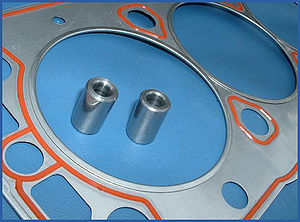Head gasket failure
Head Gasket Failure, or HGF, is all too common on the Rover ‘K’ series engine. What happens is the head gasket, which sits between the engine block and cylinder head, fails, allowing pathways between the firing area and cooling system to form.
Original designs of the were held in place by dowels that allowed minute movement of the gasket. Later gaskets are held in place by steel dowels, which do not allow movement of the gasket.
Symptoms
Signs of HGF tend to include oil in the coolant expansion bottle, or oil becoming emulsified where the coolant from the coolant ways seeps through the gasket into oil. This can normally be seen as a mayonnaise like substance inside the oil filler cap or the engine oil dipstick.
- Oil in coolant expansion bottle.
- Brown layer of foam floating on the coolant.
- Mayonnaise type substance on the oil filler cap/dipstick.
- Steam from the exhaust pipe.
- Erratic temp readings on the stack display.
- Blown radiator.
Handling
If you suspect HGF, do not drive the car and have it checked by a reputable garage. This can include checking the coolant for hydrocarbons to see if oil/gases have escaped past the gasket into the coolant ways. If the engine has overheated and the cylinder head has become warped, then the head will need to be skimmed so that it can be reseated onto a new gasket at a later date.
Treatment
Does the head need skimming? Fit new head gasket.
Precautions
Certain precautions can be taken to help alleviate the problem of HGF. These include
- Always check the coolant level.
- Hoses for damage and jubilee clips for tightness.
- Warming the engine up gradually from cold may also be beneficial.
- Fit a remote stat.
- Upgrade the head gasket.
